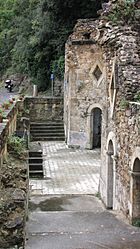Rennes-les-Bains facts for kids
Quick facts for kids
Rennes-les-Bains
|
||
|---|---|---|

The baths
|
||
|
||
| Country | France | |
| Region | Occitanie | |
| Department | Aude | |
| Arrondissement | Limoux | |
| Canton | La Haute-Vallée de l'Aude | |
| Area
1
|
18.77 km2 (7.25 sq mi) | |
| Population
(2021)
|
210 | |
| • Density | 11.19/km2 (29.0/sq mi) | |
| Time zone | UTC+01:00 (CET) | |
| • Summer (DST) | UTC+02:00 (CEST) | |
| INSEE/Postal code |
11310 /11190
|
|
| Elevation | 254–822 m (833–2,697 ft) (avg. 310 m or 1,020 ft) |
|
| 1 French Land Register data, which excludes lakes, ponds, glaciers > 1 km2 (0.386 sq mi or 247 acres) and river estuaries. | ||
Rennes-les-Bains is a small town, also called a commune, located in the Aude department in southern France. This charming place is famous for its natural hot springs. People have enjoyed bathing in these warm waters for thousands of years! Even today, these springs are used to help with conditions like rheumatism and some skin issues.
Rennes-les-Bains has a modern thermal spa with up-to-date equipment. However, some older parts of the baths had to close because of a tiny microbe found in the pipes. A new hospital was built, getting its water from a different, safe source. There was also a popular spot called the 'Bains Forts', an old washing area where young people used to swim. It became so popular that it was closed off permanently, leading some to jokingly call the town Rennes-sans-Bains (Rennes-without-Baths).
Contents
Where is Rennes-les-Bains Located?
Rennes-les-Bains is nestled in the valley of the Sals River. It is about 48 kilometers (30 miles) from Carcassonne, 20 kilometers (12 miles) from Limoux, and just 3 kilometers (2 miles) from Rennes-le-Château.
A Look Back in Time: The History of Rennes-les-Bains
The story of Rennes-les-Bains goes way back to ancient times. Archaeologists have found old items that show the spa was popular with the Romans. They had a colony nearby called Colonia Narbo Martius, which is now Narbonne.
For a long time, the village doctor also acted as the local historian. For example, in 2007, Dr. André Authier was the doctor. He wrote books about "thermalisme," which means the use of hot springs for health.
How Many People Live in Rennes-les-Bains?
The number of people living in Rennes-les-Bains has changed over the years. Here is a quick look at its population:
- 1962: 177 people
- 1968: 192 people
- 1975: 192 people
- 1982: 194 people
- 1990: 221 people
- 1999: 159 people
- 2008: 171 people
Why Else is Rennes-les-Bains Famous?
Rennes-les-Bains is known for more than just its baths! It is mentioned many times in books about Rennes-le-Château. This nearby village became very famous because of Dan Brown's novel The Da Vinci Code. Later, the author Kate Mosse set a large part of her 2007 novel Sepulchre in the area around Rennes-les-Bains.
The Priest and the Strange Book
Abbé Henri Boudet was a priest in Rennes-les-Bains at the same time that Bérenger Saunière was the priest in Rennes-le-Château. Boudet wrote a very unusual book in 1886 called La vraie langue celtique et le cromleck de Rennes-les-Bains. In this book, he claimed that all languages came from English! He tried to prove his idea by using lots of puns.
Stories of Treasure and Wizards
In 1832, a book by Auguste de Labouïsse-Rochefort called Voyages à Rennes-les-Bains first talked about a treasure hidden at Mont Blanchefort. The book told a story about a wizard who almost managed to trick the Devil and get his money. But the wizard failed because the local villagers did not help him at the most important moment. Auguste de Labouïsse-Rochefort had married the daughter of a rich man who had lost all his money.
In an earlier book from 1817, Auguste de Labouïsse-Rochefort used the phrase "Et in Arcadia ego" on the title page. This was a reference to the Academy of Arcadia, a group formed in Italy in 1690. Labouïsse-Rochefort later became a member of this Academy in 1832.
Twinning with Another City
Since July 1985, Rennes-les-Bains has been "twinned" with the city of Rennes in Brittany. This means the two places have a special friendship and cultural exchange.
See also
 In Spanish: Rennes-les-Bains para niños
In Spanish: Rennes-les-Bains para niños




